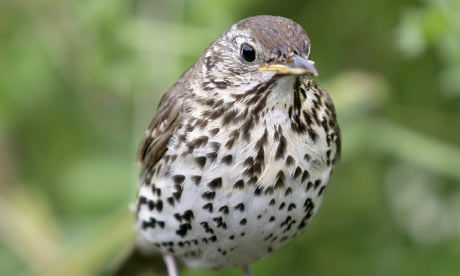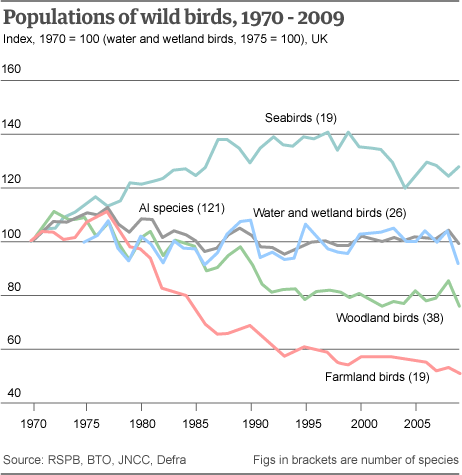
Populations of wild birds in the UK are falling dramatically with even slight recent recoveries apparently stalled, government figures showed today.
Only seabird populations remain comfortably above 1970 levels, while farmland bird numbers continue to plunge from a brief mid-1970s peak to half those of 40 years ago.
Habitat changes responsible for fewer nesting sites and food shortages were blamed last summer for sharp English farmbird losses but the reasons for the decline in woodland birds are less clear, according to the RSPB.
However research led by the British Trust for Ornithology has suggested agricultural intensification has also hit birds favouring wet grassland and moorland. Less vegetation cover and scrub, overgrazing by deer, more drainage of nearby farmland and changing winter climate may all be factors in the woodland bird decline.
Some farmland birds, such as the grey partridge, turtle dove, starling, tree sparrow, corn bunting and yellow wagtail have declined by over 70% over the period of official monitoring based on annual surveys of breeding sites and other data relating to 121 species. But wood pigeon and jackdaw populations have doubled and stock dove and greenfinch numbers risen by 50%.
Among woodland birds, huge falls have been recorded for wood warbler, willow tit, tree pipit, lesser spotted woodpecker, blackbird, dunnock, song thrush and tawny owl, among others. Yet black cap, great spotted woodpecker, green woodpecker, nuthatch and long-tailed tit are thriving
Overall figures for water and wetland birds, where comparative figures have existed only since the mid-1970s, have been more stable, although here too there are successes and failures. Species that are used to slow flowing and standing water have increased by 73%, while the index for those preferring wet grassland has fallen by 56% and those favouring fast-flowing water is 17% down. Reedbed birds - including reed warbler and reed bunting - have shown a general recovery until recently.
Seabirds such as the guillemot remain relatively abundant, but kittiwakes and arctic skuas are in decline, the figures show.
Wintering wildfowl and wader populations remain well above mid-1970 levels but have fallen from 1990s peaks. European white-fronted goose, mallard, pochard, pintail, scaup, oystercatcher, redshank and ringed plover are among those in decline, but there are more than tenfold increases in Svalbard light-bellied Brent goose and gadwall and a six-fold rise in black-tailed godwit.
Mark Avery, the RSPB's conservation director, said: "It is staggering that farmland birds, such as the turtle dove and lapwing, have reached such a low ebb. But the good news is that we know how to turn around these declines."
A secure future for farmland wildlife rested with farmers being financially rewarded for managing land in an environmentally friendly way, through agri-environment schemes, he said.
The Department for the Environment, Food and Rural Affairs (Defra) is currently reviewing key entry level stewardship (ELS) payments to farmers, which cover 70% of England's farmland. "Defra only has to tweak ELS a little to ensure a recovery in farmland birds such as skylarks and corn buntings," said Avery.
The RSPB said a "staggering" 50 of 250 species occuring regularly in Britain were now on a growing "red" list of species whose conservation was a concern, the latest being the cuckoo.
Richard Benyon, minister for the natural environment in England, said: "Our bird populations are a good indicator of the wider health of our environment and it is clear that more needs to be done to support the recovery of farmland and woodland birds. Many people will have a part to play and we look forward to working with charities and landowners to reverse this trend."
Benyon said the government was doing "more than ever" to protect our wildlife. "The area of land protected or managed under woodland and agri-environment schemes is increasing. The condition of our protected sites is improving and it is great to see members of the public giving more of their time to conservation volunteering."
A white paper on the natural environment will be published this spring.




Reader Comments
to our Newsletter